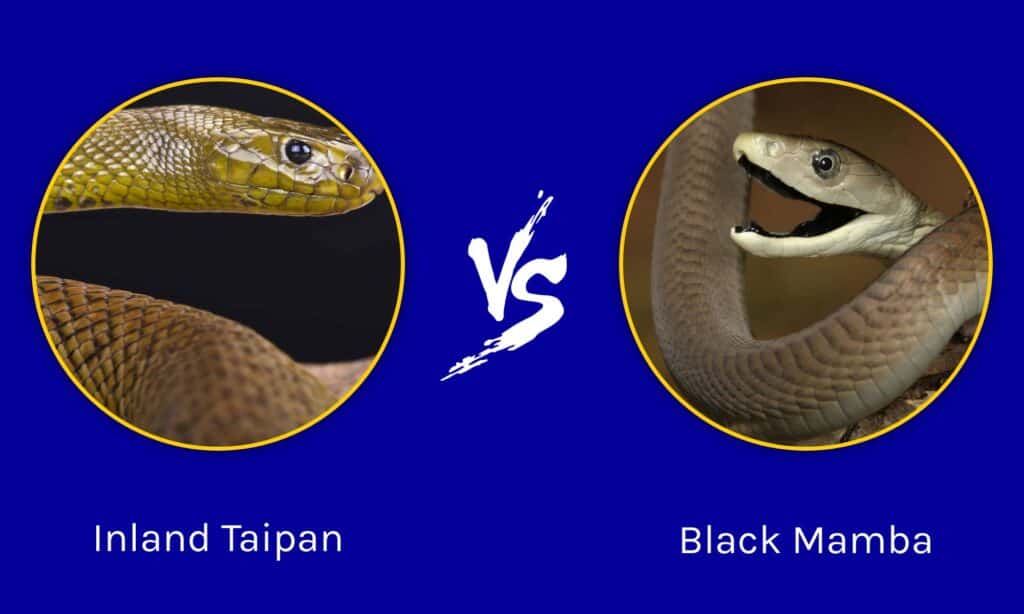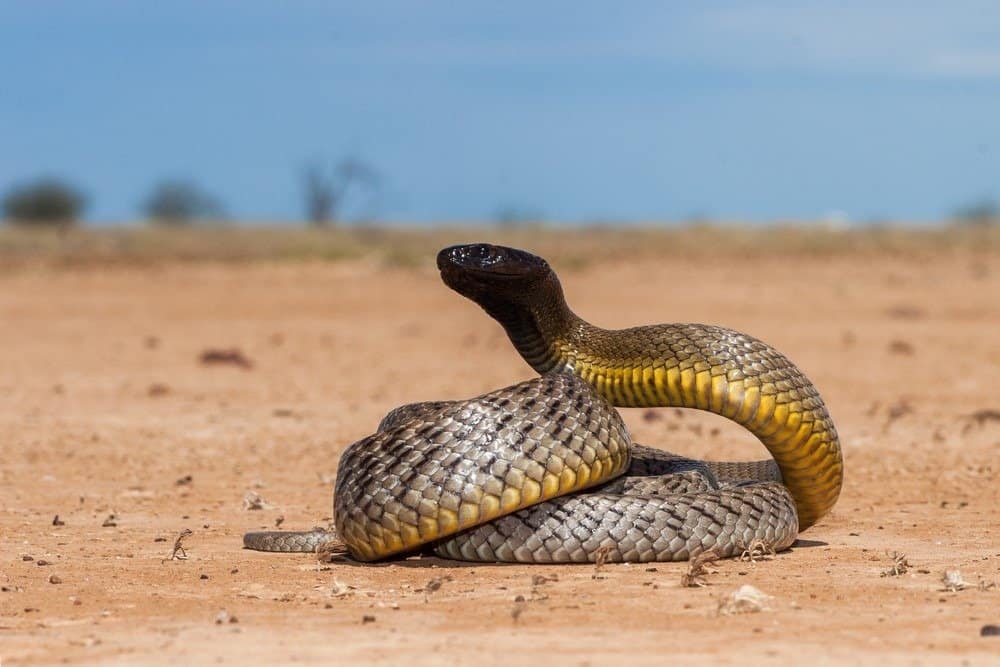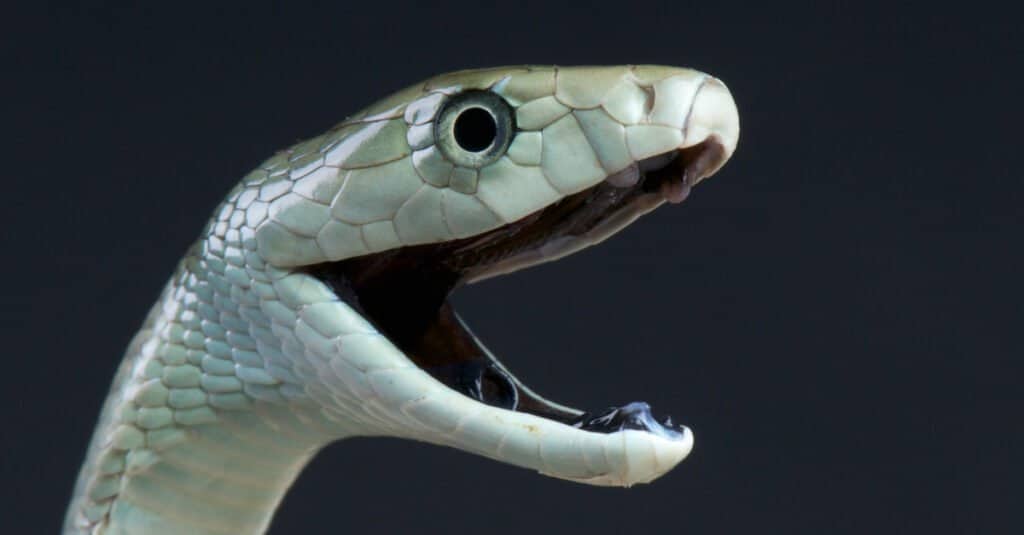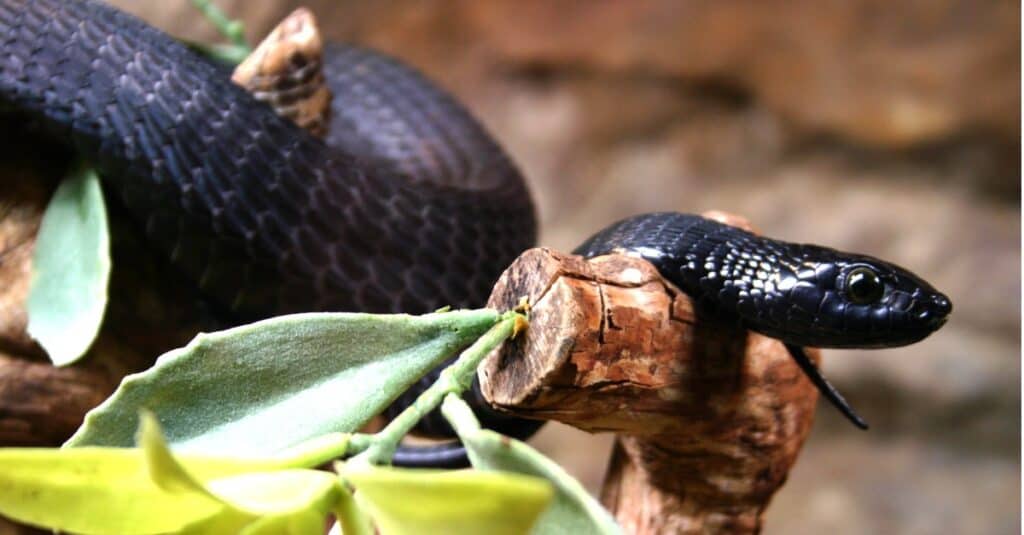Many venomous snakes populate the world today. The inland taipan, also called the fierce snake, is said to have the deadliest venom of any snake. However, the black mamba is widely feared and considered the most dangerous snake alive today. We have the data to show which of the creatures is deadlier to human beings, but what about in a contest between each other? Take a look and see how an inland taipan vs black mamba fight would play out and which snake would still be alive at the end!
Comparing an Inland Taipan and a Black Mamba

| Characteristic | Inland Taipan | Black Mamba |
|---|---|---|
| Size | Weight: 3lbs-4.4lbs Length: 4ft-6ft, up to 9ft maximum | Weight: 3.5-4.5lbs Length: 6ft-9.5ft, up to 14ft maximum |
| Speed | 5 mph (estimated, not observed) | 7-20 mph |
| Envenomation | – Considered the deadliest venom in the world – 44mg average venom load with 110mg maximum – Capable of killing between 100 and 280 humans with a single bite – Nearly 100% envenomation rate and delivers several bites | – Powerful venom that can kill humans quickly – 100g-120g of venom per bite on average with 400g maximum – Capable of killing 10-20 humans with a single bite – 100% envenomation rate and delivers several bites |
| Aggression | – Prefers to run away from confrontations | – A highly aggressive snake that doesn’t back down from a fight |
| Offensive Capabilities | – Accurate bites – Fast, numerous fast bites | – Capable of raising 40% of its body off the ground to land strikes from far away – Bites several times – Can use its length and weight to wrestle other snakes |
| Predatory Behavior | – Ambush predator | – Ambush predator |
What Are the Key Differences Between an Inland Taipan and a Black Mamba?

Inland Taipans are smaller than black mambas by more than three feet.
©Cormac Price/Shutterstock.com
The greatest difference between an inland taipan and a black mamba includes their size, coloration, and demeanor. Inland taipans are yellowish-brown and black, grow up to 6ft long on average, and are known for being placid snakes. But black mambas are grey and brown, grow up to 9.5ft on average, and are highly aggressive snakes.
These unique qualities will help us differentiate between the two animals and grant us insights into which is more likely to win a battle against the other. Along with other valuable data, we can discover the reptile with the greatest edge.
What Are the Key Factors in a Fight Between an Inland Taipan and a Black Mamba?

Inland taipans strike quickly, but they can’t strike over long distances like the black mamba.
©iStock.com/Ken Griffiths
The key factors in a fight between an inland taipan and a black mamba will include their size, speed, venom, and mentality. These animals are only similar in that they deliver venom into their prey to kill them. Other than that, they are very unique. Those differences will ultimately determine which snake lives and which one perishes.
Inland Taipan vs Black Mamba: Size
Black mambas are larger than inland taipans. The average length of a black mamba is between 6ft and 9.5ft, and they can grow upwards of 14ft long. Also, they weigh up to 4.5 pounds. The inland taipan weighs just about the same amount as a black mamba, but it’s far shorter. They grow up to 6ft long at their high-end average, and their maximum length is 9ft.
Black mambas have the size advantage.
Inland Taipan vs Black Mamba: Speed and Movement
Black mambas are faster than inland taipans. The black mamba is believed to move at speeds between 7 and 20 mph, though the latter is over very short distances. Some legends exist regarding the black mamba’s speed, such as chasing down men on horseback. That’s just not true, though.
Inland taipans are shy creatures, so measuring their speed is difficult. Their max speed is estimated to be about 5 mph, but their strike speed is greater.
Inland Taipan vs Black Mamba: Envenomation
The inland taipan is believed to have the deadliest venom in the entire world, capable of killing between 100 and 280 humans with a single bite. They don’t inject much venom per bite compared with other creatures. However, their venom is so deadly that they do not need to inject that much. Moreover, they almost always inject venom in their bites; dry bites are rare.
Black mambas also have incredibly deadly venom that can kill 20 humans with a single bite. Like the inland taipan, they have a 100% envenomation rate; they bite to kill in all cases. They can inject up to 400g of venom into their foes in a single bite, and the venom quickly overtakes their prey.
The inland taipan has an edge in terms of venom, but it’s a close one.
Inland Taipan vs Black Mamba: Aggression
Black mambas are far more aggressive than inland taipans. The fierce snake doesn’t live up to its name. In fact, these snakes frequently hide from humans and have been safely handled by people like Steve Irwin without incident.
Black mambas have a very nervous demeanor. When they feel uncertain, they turn that nervous energy into aggression. As a result, the black mamba is much more dangerous to be around because it will attack humans and other animals without much provocation.
The black mamba is far more aggressive than the inland taipan.
Inland Taipan vs Black Mamba: Combat Skills
Both the inland taipan and the black mamba are highly venomous snakes that ambush their prey and envenomate them. Once their prey is bitten, it’s just a matter of time until it’s dead and ready to be consumed.
The major difference between these creatures is that the black mamba can draw more of its body off the ground to strike. That allows them to cover more distance and to attack farther up the body of animals or human beings, increasing the likelihood their bites turn fatal.
Both snakes are poised to be deadly contestants in this fight.
Who Would Win in a Fight Between an Inland Taipan and a Black Mamba?

Black mambas have coffin-shaped heads and black mouths that hint at their venom’s toxicity.
©reptiles4all/Shutterstock.com
A black mamba would win a fight against an inland taipan because it’s larger and far more aggressive than the other snake.
Still, when we talk about the “winner” of a fight between two of the deadliest animals alive, we can’t truly say one will survive and the other won’t. In this case, the snake that kills the other first is the winner, even if they are probably going to die, too.
So, if for some reason, the snakes bit each other at roughly the same time, the inland taipan’s powerful venom would probably kill the black mamba before the mamba’s venom killed it. In that case, the inland taipan would technically be the winner.
But the inland taipan’s first reaction would probably be to flee from this fight, and that would put it at a major disadvantage. The black mamba is faster and far more aggressive. Since the black mamba is longer than the inland taipan and can lift a lot of its body off the ground to attack, it would probably land the first bite against the taipan before it can counter.
The black mamba can then sit and wait for the venom to take hold, or it could turn into a wrestling and biting match. If the latter happens, both snakes will eventually die. However, if the black mamba uses its natural aggression against a fleeing taipan, it will win the battle outright.
Either way, the black mamba is the more likely winner in this case.

Black mambas are both terrestrial and arboreal snakes that live in
Africa
.
©iStock.com/Nicole_Marschall
Where Do Inland Taipan Snakes Live?
The inland taipan is a species of snake that can be found in semi-arid regions of central east Australia. It is part of the Elapidae family, and it has several names, including western taipan, small-scaled snake, and fierce snake. This particular species is extremely venomous and should not be handled without extreme caution. Its habitat consists mainly of open woodlands, scrubland, grassland plains, and rocky outcrops. The Inland Taipan typically lives in burrows or crevices hidden among rocks during the day to avoid predators. At night they come out to hunt for their prey which includes small mammals such as rodents and birds, as well as lizards and frogs.
Where Do Black Mamba Snakes Live?
Black Mamba Snakes are native to the African continent and are found mainly in sub-Saharan Africa. They have been seen as far north as Senegal and Somalia and southwards into South Africa, Zimbabwe, Mozambique, Namibia, Botswana, and Angola. They prefer dry savannah regions but can also be found in more moist areas such as rainforests or near water sources. Black Mambas prefer warm climates with temperatures between 77°F during the day up to 95°F. During cold nights they will enter a state of brumation where their body temperature drops until the environment warms again.
Up Next…
Nobody wants to meet either of these snakes face-to-face. But you can at least keep reading to get to know them better from a distance.
Inland Taipan vs Mongoose: Who would win in a fight? Let’s imagine what would happen if the fierce snake went up against the feisty mammal who’s a pro at hunting snakes and can even resist venom.
What do Black Mambas Eat? We know that the black mamba and the inland taipan would never meet in the wild since they’re on totally different continents. So what animals does a black mamba actually hunt for food?
Black Mamba vs Green Mamba– These two snakes share some territory, so let’s compare and contrast them.
The photo featured at the top of this post is © Ken Griffiths/Shutterstock.com
Discover the "Monster" Snake 5X Bigger than an Anaconda
Every day A-Z Animals sends out some of the most incredible facts in the world from our free newsletter. Want to discover the 10 most beautiful snakes in the world, a "snake island" where you're never more than 3 feet from danger, or a "monster" snake 5X larger than an anaconda? Then sign up right now and you'll start receiving our daily newsletter absolutely free.
Thank you for reading! Have some feedback for us? Contact the AZ Animals editorial team.






